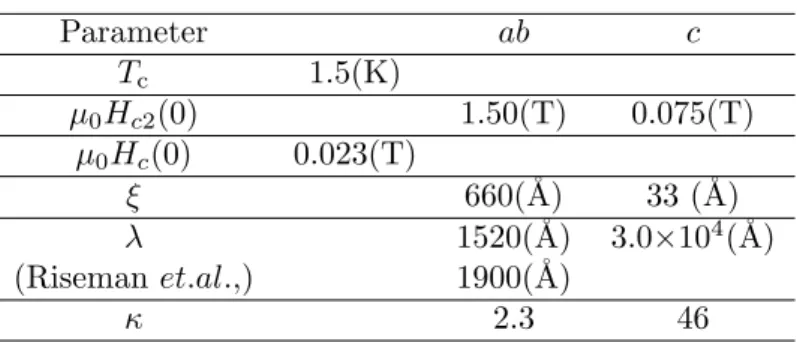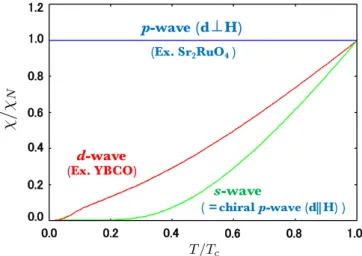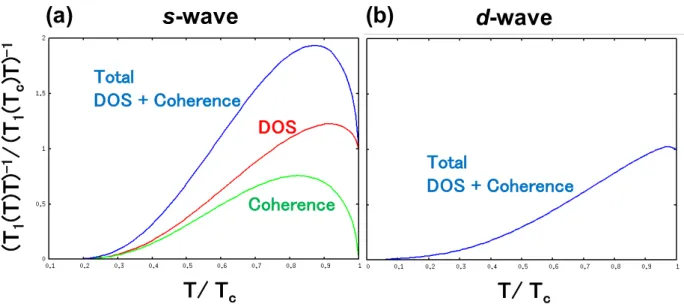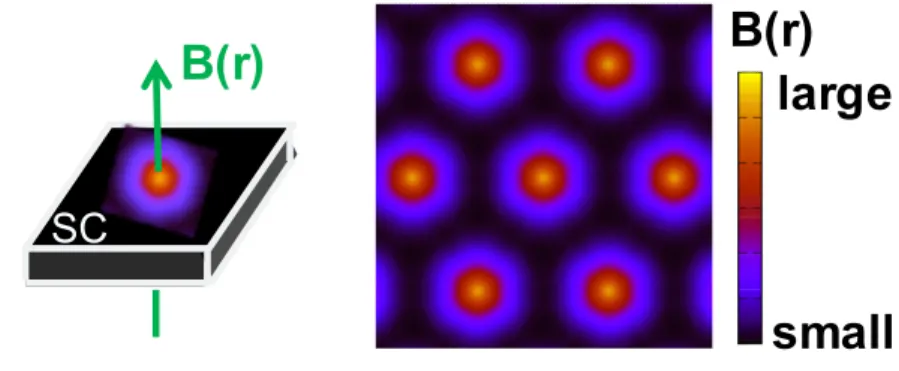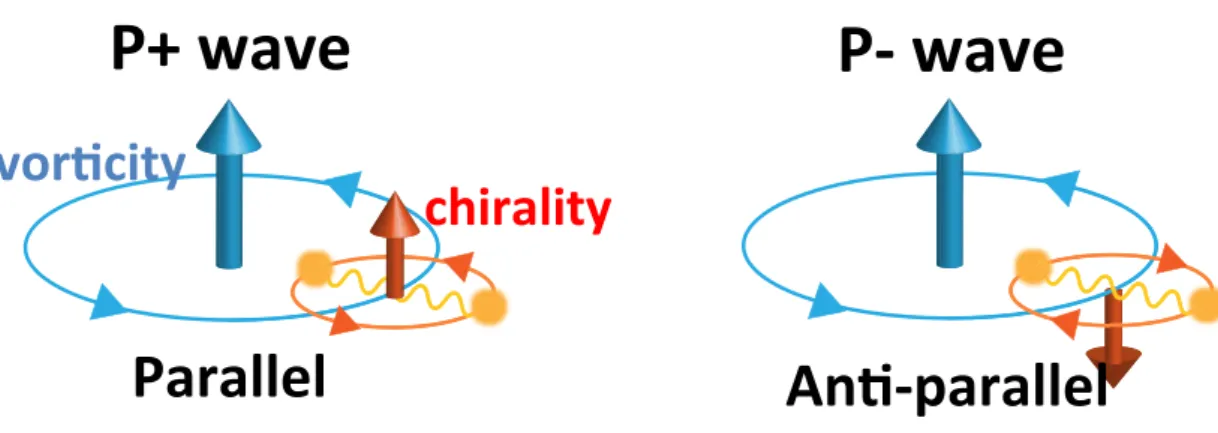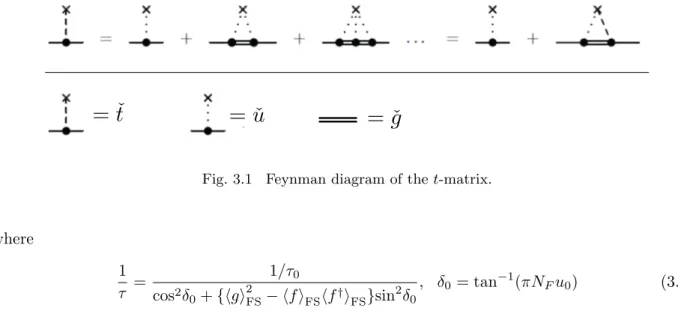Local electronic states and pair amplitudes
in the vortex states of spin-triplet superconductors
2018, March
Kenta Tanaka Graduate School of
Natural Science and Technology (Doctor’s Course)
OKAYAMA UNIVERSITY
i
Contents
Chapter 1 Introduction 1
1.1 Background . . . 1
1.2 Purpose of this thesis . . . 2
1.3 Outline of this thesis . . . 2
Chapter 2 Symmetry and property of spin-triplet superconductors in the vortex states 4 2.1 Unconventional superconductors . . . 4
2.2 Spin-triplet chiral and helicalp-wave states . . . . 4
2.3 Characteristics and mysteries of a superconductor Sr2RuO4 . . . 7
2.4 NMR relaxation rate measurement for superconductors . . . 11
2.5 Vortex states of spin-triplet pairing superconductors . . . 13
2.6 Odd-frequency Cooper pairs . . . 16
Chapter 3 Formulation 17 3.1 Quasiclassical theory . . . 17
3.1.1 Gor’kov theory . . . 17
3.1.2 Wigner representation and Moyal product . . . 18
3.1.3 Quasiclassical approximation for Gor’kov equations . . . 19
3.1.4 t-matrix approximation . . . . 21
3.2 Linear response theory . . . 22
3.2.1 Callen-Welton formula . . . 23
3.2.2 NMR spin-lattice relaxation rateT1−1 in quasiclassical theory . . . 25
3.2.3 NMR spin-spin relaxation rateT2−1in quasiclassical theory . . . 28
3.3 Calculation method . . . 29
Chapter 4 Site-selective NMR 34 4.1 Site-selective NMR method . . . 34
4.2 Model and parameters . . . 35
4.3 Local NMR spin-lattice relaxation rateT1−1 for chiralp-wave state . . . . 36
4.4 Relation to Odd-frequency Cooper pairs . . . 39
4.5 Impurity effects on the local NMR spin-lattice relaxation rate T1−1 . . . 41
Chapter 5 LocalT1−1 andT2−1 in the chiral and helical p-wave states 43 5.1 Site andB-dependence of the local NMR relaxation rate . . . 43
5.2 Negative coherence effect and odd-frequency s-wave Cooper pair . . . . 44
5.3 Summary of this chapter . . . 48
Chapter 6 Spin-polarized LDOS 49 6.1 Spin-polarized STM/STS method . . . 49
6.2 Helicalp-wave superconductor . . . . 49
6.3 Model and parameter . . . 50
6.4 Spin-polarized LDOS . . . 50
6.5 H-dependence of the order-parameter . . . 50
Contents ii
6.6 H-dependence of zero-energy spin-polarized DOS and LDOS . . . 51
6.7 Energy-dependence of the spin-polarized LDOS . . . 53
6.8 Impurity effect on the spin-polarized LDOS . . . 54
6.9 Summary of this chapter . . . 54
Chapter 7 Conclusion 57 7.1 Summary of this thesis . . . 57
7.2 Future studies . . . 59
A Riccati equation 62 A.1 Matrix Riccati equation . . . 62
A.2 Symmetry of ˇg, and ˆa, ˆb . . . 63
B NMR relaxation rates in the low temperature limit 65 C Kramer-Pesch approximation 68 C.1 Analytic solution of the Riccati equation . . . 68
C.2 Zeroth-order Riccati equation . . . 69
C.3 First-order Riccati equation . . . 70
C.4 Quasiclassical Green’s functions . . . 71
C.5 NMR relaxation rate around the vortex center in the lowT limit . . . 72
Bibliography 74
Abstract
Anomalous properties of local electronic states around vortex cores are theoretically investigated in chiral p-wave and helical p-wave pairing states of spin-triplet superconductors, in order to find phenomena tightly relating to the chirality of the orbital component and the d-vector symmetry of the spin component for the spin-triplet Cooper pairs. So far, the d-vector symmetry has not been clarified, even by many experimental and theoretical previous studies for the candidate materials for the spin-triplet superconductors, Sr2RuO4 and UPt3. In this study, by numerical calculations of selfconsistent Eilenberger theory, after the spatial structures of multiple order parameters and internal magnetic fields are quantitatively determined in the vortex lattice state, behaviors of the local nuclear magnetic resonance (NMR) relaxation rates and the spin-polarized local density of states (LDOS) are revealed.
In the study of the local NMR spin-lattice relaxation ratesT1−1, difference ofT1−1behavior between two chiralitiesLz =±1 is quantitatively estimated in the site- and resonance frequency-dependences of the site-selective NMR measurement. There, the localT1−1 around the vortex core shows anoma- lous suppression around the vortex core by the contribution of negative coherence terms due to the odd-frequency Cooper pairs with Majorana states. Next, from the comparative study of T1−1 with spin-spin relaxation rate T2−1 in the vortex lattice state of two-type chiral p-wave states (d∥z or d∥x) and a helicalp-wave state, it is found that difference between T1−1 andT2−1 occurs depending on the relative orientations of the d-vector and the NMR pulsed field.
In the study of the LDOS in the vortex lattice state of a helicalp-wave superconductor, the instabil- ity of the helicalp-wave state at high magnetic fields and the appearance of the spin-polarized LDOS around the vortex core are confirmed. In addition, the site-, magnetic field-, and energy-dependences of the spin-polarized LDOS are clarified to investigate the spin-polarized LDOS behaviors in the spin-polarized scanning tunneling microscopy and spectroscopy (STM/STS) measurements. The zero-energy spin-polarized LDOS induced around the vortex core shows stronger value compared to the normal state DOS. This zero-energy state is related to the Majorana states. Moreover, the energy-dependence of the spin-polarized LDOS at the vortex center shows the sign change behaviors.
These results will stimulate future studies of unconventional superconductors, providing a possible new method to identify the d-vector of the pairing symmetry of candidate materials for spin-triplet superconductors, and detect information of anomalous electronic states due to the odd-frequency Cooper pairs and Majorana states around the vortex core.
1
Chapter 1
Introduction
1.1 Background
In 1911, the superconductivity was discovered by Kamerlingh Onnes [1]. After decades, mechanism of the superconductivity so-called conventional superconductivity with the isotropic s-wave pairing state was explained by phenomenological Ginzburg-Landau theory [2] and microscopic Bardeen- Cooper-Schrieffer theory [3]. In the conventional superconductivity, Cooper pairs are formed as bound states of two electrons in the momentum space by the electron-phonon interaction.
Since the discovery of the heavy-fermion superconductors CeCu2Si2 in 1979 [4] and the high- Tc cuprate superconductors in 1986 [5], various unconventional superconductivities based on non- phonon mechanisms have been discovered. Reflecting the non-phonon mechanism such as spin- fluctuations, the superconductivity is realized by spin-singletd-wave pairings in the high-Tccuprates and heavy-fermion CeCoIn5. On the other hand, spin-triplet pairing superconductivity is also sug- gested in a ruthenate superconductor Sr2RuO4 [6–8], a heavy fermion superconductor UPt3 [9–11], and a doped topological insulator CuxBi2Se3 [12, 13]. These spin-triplet superconductors have also attracted much attention as topological superconductors since exotic quantum states such as odd- frequency Cooper pairs and Majorana states are expected in the vortex core and surface regions.
However, the pairing symmetries of these candidate materials have been still discussed. For exam- ple, although Sr2RuO4 is the leading candidate material for the chiral p-wave superconductor, the helicalp-wave state also has been suggested as another scenario of Sr2RuO4, as explained in Chap. 2.
The definitions of chiral and helical p-wave pairings are also noted in Chap. 2. For UPt3, it is also not settled whether the possible pairing symmetry is chiral or helical states. The properties of the possible spin-triplet pairings are listed in Table 1.1.
On the other hand, the first unconventional pairing of superconductivity did turn out not in a superconductor, but in a superfluid3He. And, it is found that there are two-type superfluid phases.
The main phase is the so-called B-phase, and first described theoretically by Balian and Werthamer in 1963 [14]. The pairing symmetry of the B-phase is represented by the helical p-wave-like. In a narrow region of temperature and pressure phase diagram, another phase known as the A-phase exists. This phase was first theoretically described by Anderson and Morel in 1961 [15, 16]. The A-phase is represented by the chiralp-wave pairing. Under a magnetic field, the spin-polarized state so-called A1-phase also appears. The orbital symmetry in A1-phase is the same as that in the A- phase [17]. Therefore the various pairing states realize in the superfluidity of 3He. In the study for the vortex and surface states of superfluid3He, the exotic states such as odd-frequency Cooper pairs and Majorana states also have been investigated.
Therefore, understanding the mechanism of the unconventional superconductivity is important to realize and control the exotic superconductivity such as high-Tc superconductivity and topolog- ical superconductivity. However, the pairing symmetry of the candidate materials for spin-triplet superconductors has been still under debate. It is necessary that we investigate unique behaviors of physical quantities depending on the spin-triplet pairing symmetry to distinguish the pairing symmetry of the candidate materials.
Chapter 1 Introduction 2 Material Time-reversal symmetry Possible pairing state
Sr2RuO4 Broken Chiralp-wave
(Two scenarios) Preserved Helicalp-wave
UPt3 B-phase Broken Chiralf-wave
(Two scenarios) Preserved Helicalf-wave
3He A-phase Broken Chiralp-wave
3He B-phase Preserved Helicalp-wave-like
3He A1-phase Broken Spin-polarized p-wave
AxBi2Se3 Preserved p- or f-wave
A = Cu, Sr, Nb, Tl
Table 1.1 The possible pairing and time-reversal symmetry of the candidate materials of spin- triplet superconductors. The possible spin-triplet pairing symmetries of Sr2RuO4 and UPt3
B-phase are suggested in two scenarios, chiral or helical states.
1.2 Purpose of this thesis
To identify the d-vector symmetry of the candidate materials for the spin-triplet superconductors, I focus on and investigate the behaviors of the local NMR relaxation rates and the spin-resolved LDOS in the vortex lattice states, reflecting the chirality of the pairing state and the direction of thed-vector. These physical quantities are expected to be measured by the site-selective NMR and the spin-polarized STM/STS measurements. In addition, I study the relation between the physical quantities and the anomalous electronic states induced around the vortex core such as odd-frequency Cooper pairs and Majorana states. I would like to provide a possible new method to identify the d-vector symmetry of the candidate materials for the spin-triplet superconductors, and detect the anomalous electronic states.
1.3 Outline of this thesis
In this thesis, the vortex states of the spin-triplet chiral and helical p-wave superconductors are investigated by the quasiclassical Eilenberger theory. This thesis consists of two subjects; the local NMR relaxation rates and the spin-polarized LDOS. In the vortex state of the chiral and helical p-wave states, the sub-components of order-parameter are induced around the vortex core by the interaction between the vorticity and the chirality. We focus on the behaviors of the local NMR relaxation rate and the spin-resolved LDOS reflecting the induced sub-components. In addition, we discuss the relation between the sub-components and odd-frequency Cooper pairs with Majorana states.
In Chap. 2, I review briefly the symmetry and properties of spin-triplet superconductors in vortex state. To understand calculation results of the local NMR relaxation rates in this thesis, we ex- plain the NMR measurement for bulk superconductors as introduction to the spatial resolved NMR measurement in the vortex state called site-selective NMR measurement. In addition, I discuss the properties of the vortex states of spin-triplet pairing superconductors such as chiral and helical p-wave states. The last of this chapter is devoted to the explanation of odd-frequency Cooper pairs.
In Chap. 3, I introduce the quasiclassical Eilenberger equation from the BCS Hamiltonian, and also consider the self-energy for non-magnetic impurity effects by thet-matrix approximation. Moreover, we show the general formulation of the local NMR spin-lattice relaxation rateT1−1and the spin-spin relaxation rate T2−1 based on the quasiclassical Eilenberger theory. The selfconsistent calculation method of the quasiclassical Eilenberger theory in the vortex lattice state is also described.
In Chap. 4, I calculate the local NMR spin-lattice relaxation rateT1−1 in the vortex state of chiral
Chapter 1 Introduction 3 p-wave superconductors to investigate the chirality dependence of the local T1−1. To obtain the estimations for the local the localT1−1 in the site-selective NMR measurement, I calculate the site- and resonance frequency-dependences of the local T1−1 in the vortex lattice state, and this study can obtain valid results at arbitrary magnetic fields. I also investigate the impurity effects on the resonance frequency-dependences of the localT1−1. I show that the localT1−1around the vortex core is anomalously suppressed by the negative coherence effect. This anomalous behavior is related to the odd-frequency Cooper pairs with Majorana states.
In Chap. 5, I investigate the local NMR spin-spin relaxation rate T2−1in the vortex state of chiral and helicalp-wave superconductors, focusing the dependence of the d-vector orientation, From the comparative study of the localT1−1with the spin-spin relaxation rateT2−1in the vortex states of two- type chiralp-wave states (d∥zord∥x) and the helicalp-wave state, I show that the difference between the localT1−1 and T2−1, depending on the relation between the orientations of thed-vector and the NMR pulsed field. I show that the local T2−1 around the vortex core is anomalously suppressed by the negative coherence effect. This anomalous behavior is related to the spin-polaried odd-frequency Cooper pairs with Majorana states.
In Chap. 6, I show that the spin-polarized LDOS appears in the vortex state of a helical p-wave superconductor, and confirm the instability of the helical state at high magnetic fields. The spin- polarization and the instability are induced by the vorticity coupling to the chirality of up-spin or down-spin pairs of the helical state. To investigate the behavior of these phenomena, we calculate the site-, magnetic field-, and energy-dependences of the spin-polarized LDOS. The zero-energy spin- polarized LDOS induced around the vortex core is related to the Majorana zero-energy state. I also study the impurity effects on the energy-dependence of the spin-polarized LDOS at the vortex center.
The last chapter is devoted to the summary and prospective views of future studies.
4
Chapter 2
Symmetry and property of spin-triplet superconductors in the vortex states
2.1 Unconventional superconductors
The pairing symmetry in a bulk superconductor is classified as G= G×SU(2)×K×U(1)
where G is symmetry group of the crystal lattice, SU(2) is symmetry group of the spin rotation, K is time-reversal symmetry, and U(1) is global gauge symmetry. Since the phase of the superconducting wave function is locked in a certain value, the gauge symmetry of U(1) has to be broken.
The superconductivity protecting the pairing symmetry except for U(1) is called conventional superconductivity, which represents in isotropic s-wave pairing on the Fermi surface, spin-singlet, and time-reversal invariance. The conventional superconductivity is described by the BCS theory with electron-phonon pairing interaction. On the other hand, the superconductivity breaking other symmetry in addition to U(1) is called unconventional superconductivity. For example, the orbital (spin) symmetry in anisotropic G (in broken SU(2)) system represents non s-wave states such as d-wave states (in spin-triplet states), and provides the orbital (spin) degree of freedom. If chirality of Cooper pairs in the orbital or spin symmetry exists owing to the degree of freedom, time-reversal symmetry of superconductivity is broken. Therefore, in the study for unconventional superconduc- tors, it is most important issue to distinguish the pairing symmetry since it is tightly related to the mechanism of the unconventional superconductivity.
2.2 Spin-triplet chiral and helical p-wave states
Many experiments and theories have investigated the fermion superfluid of 3He, and supported that spin-triplet chiral (helical-like)p-wave state is realized in the Anderson-Brinkman-Morel phase (Balian-Werthamer phase). As shown in Fig. 2.1, the order-parameter of the spin-triplet p-wave pairing state is described as 3×3 degree of freedom where the orbital and spin angular momentum of Cooper pair is, respectively, Lz =−1,0,+1 andSz =−1,0,+1. The possible symmetry is listed in Table 2.1. In this study, pz component has not been taken into account since I consider the cylindrical two dimensional Fermi surface for simplicity. In the chiralp-wave state, the pairing state has finite chirality, i.e., angular momentum Lz =±1 for p± =px±ipy wave pairing. Owing to the chirality of pairing state, the time-reversal symmetry is broken.
The spin-components of order-parameters are described as 2×2 matrix
∆(k) =ˆ
(∆↑↑ ∆↑↓
∆↓↑ ∆↓↓
)
Chapter 2 Symmetry and property of spin-triplet superconductors in the vortex states 5 In the spin-singlet pairing symmetry, ∆↑↑ = ∆↓↓ = 0 and ∆↑↓ =−∆↓↑ = ∆s, while for the spin- triplet case, ∆↑↓ = ∆↓↑. Here,kis a wave vector in the momentum space.
For the spin-singlet pairing, the order-parameter can be written as
∆(k) =ˆ
( 0 ∆s
−∆s 0 )
.
For the spin-triplet pairing, the order-parameter in the spin space can be represented in terms of a three-component complex vector so-called d-vector d(k) = [dx(k), dy(k), dz(k)]. The d-vector is defined as
∆σσ′(k) = [i ∑
µ=x,y,z
(dµ(k)·σˆµ)ˆσy]σσ′,
where σ, σ′ = ↑(up-spin) or ↓(down-spin), and ∆σσ′ denotes (σ, σ′) spin component of the order- parameter ˆ∆. And, ˆσµ is the Pauli matrix defined as
ˆ σx =
(0 1 1 0 )
,σˆy=
(0 −i i 0
) ,σˆz =
(1 0 0 −1
) .
Therefore,
∆(k) =ˆ
(∆↑↑ ∆↑↓
∆↓↑ ∆↓↓
)
=
(−dx+idy dz
dz dx+idy
)
Using the d-vector formalism, the chiral p±-wave state is described as d(k) = (kx±iky)n (∀n∈Z3).
And, the amplitude of order-parameter shows the full-gap state where|∆|= (k2x+ky2)1/2in Table 2.1.
Since the phase of the order-parameter is written as ∆(k) =|∆(k)|e±iLzθk whereθk= tan−1(ky/kx), the time-reversal symmetry of pairing state is broken.
On the other hand, in the helical p-wave state, the time-reversal-invariant pairing state appears sinceLz =±1 are quenched with the degeneracy between up-spin and down-spin pairs. As shown in Fig. 2.1, The up-spin (down-spin) pair’s order-parameter ∆↑↑(↓↓) characterized by Sz = +1(−1) has chiralityLz =−1(+1) so that the bulk condition isLz+Sz = 0 [18]. Thed-vector of the helical p-wave state is described asd(k) =kxx+kyy= [(kx−iky)(x+ iy) + (kx+ iky)(x−iy)]/2, where x = (1,0,0),y = (0,1,0). And, the other-type helical p-wave state where Lz+Sz = +2 or −2 is represented in Table 2.1. These helical p-wave states form the full-gap state on the Fermi surface,
|∆|= (kx2+ky2)1/2.
From the 2×2 matrix equation ˆ∆(k) = i[d(k)·σ]σˆ y, the amplitude of the order-parameter|∆|ˆ can be represented as
|∆(k)|2= ˆ∆(k) ˆ∆†(k)
=|d(k)|2σ0+ i[d(k)×d∗(k)]·σˆ
where the Pauli matrix in the vector form ˆσ = (ˆσx,σˆy,σˆz). If |d×d∗|= 0, |d(k)|2 corresponds to the amplitude of order-parameter |∆(k)|2. The chiral and helical p-wave states satisfy the unitary condition |d×d∗| = 0. As shown in Fig. 2.2 in the unitary condition |d×d∗|= 0, the spins of the Cooper pair lie in the basal plane as d⊥S. For the unitary state, all the electrons form the pairing state. On the other hand, in the non-unitary state where |d×d∗|̸=0, it has two energy gaps and some electrons do not form the pairing state even at the absolute zero temperature. If thed-vector is lying in the xy-plane, the spin-polarization and the two energy gaps in the non-unitary pairing state appear where|∆↑↑(k)|2− |∆↓↓(k)|2= 2i[d(k)×d∗(k)]z̸=0.
From many experimental and theoretical studies, ruthenate superconductor Sr2RuO4, heavy fermion superconductor UPt3, and other materials such as CuxBi2Se3 are suggested as spin-triplet
Chapter 2 Symmetry and property of spin-triplet superconductors in the vortex states 6
Fig. 2.1 The schematic figure for thed-vector of chiral and helicalp-wave states.
d-vector symmetry Spin-components of Time-reversal Analogy to
[direction] order-parameter ˆ∆(k) symmetry 3He
Chiral (kx±iky)x |∆↑↑(↓↓)|=√
kx2+ky2 Broken A-phase [d∥n] (kx±iky)y |∆↑↑(↓↓)|=
√
kx2+ky2 Broken A-phase n=x,y,z (kx±iky)z |∆↑↓(↓↑)|=
√
kx2+ky2 Broken A-phase Helical kxx±kyy |∆↑↑(↓↓)|=√
kx2+ky2 Preserved B-phase [d∥xy] kxy±kyx |∆↑↑(↓↓)|=
√
kx2+ky2 Preserved B-phase Others (kx±ky)z |∆↑↓(↓↑)|=|kx±ky| [line node] Preserved
[d∥z] kxz |∆↑↓(↓↑)|=|kx| [line node] Preserved Non-unitary kxx±ikyy |∆↑↑(↓↓)|=|kx±(∓)ky| Broken
kxy±ikyx |∆↑↑(↓↓)|=|kx∓(±)ky| Broken [d∥xy] (x±iy)(kx±ky) |∆↑↑|= 2|kx±ky| [line node] Broken
(x±iy)(kx±iky) |∆↑↑|= 2
√
k2x+ky2 Broken A1-phase Table 2.1 The possible symmetry of the spin-triplet p-wave pairing state on a cylindrical Fermi surface [7]. Thed-vector representations and the spin-components of order-parameter are described, classified into the preserved or broken time-reversal symmetry. Reference to
3He are for the analogous three-dimensional states. The pairing state in the B-phase of3He is represented by the helical p-wave-liked= (kx, ky, kz).
Chapter 2 Symmetry and property of spin-triplet superconductors in the vortex states 7
(a)
(b)
(c)
Helical p-wave
Chiral p-wave
Chiral p-wave in an applied field
L
zd
S
zApplied field
Fig. 2.2 The schematic figures forS and d of the Cooper pair in the spin-triplet (a) helical p-wave and (b) chiral p-wave pairing states, and (c) chiralp-wave state asd⊥H.
superconductors. For Sr2RuO4 and UPt3, the triplet pairing state is investigated by the Knight shift measurement [19–22] and the broken time-reversal symmetry owing to chirality is supported byµSR [23, 24] and polar Kerr effect measurements [25, 26]. These experimental evidence have sup- ported that Sr2RuO4 and UPt3 realize the chiral spin-triplet superconductivity. However, in these materials, the possible pairing symmetry has been discussed other than the chiralp-wave state. For example, the helicalp-wave state also has been suggested as another scenario of the superconductivity in Sr2RuO4 [18, 27, 28] to explain the measurements such as magnetic field orientation dependence of the Knight shift [19, 20] and Pauli-limit behavior of upper critical field [29]. The details of the previous studies are explained in the next section.
2.3 Characteristics and mysteries of a superconductor Sr
2RuO
4The ruthenate superconductor Sr2RuO4is a candidate material for the spin-triplet chiralp-wave su- perconductor. Sr2RuO4has the perovskite crystal structure of the cuprate superconductor La2CuO4, represented by the space groupI4/mmm[30]. The primitive cell is tetragonal body centered as shown in Fig. 2.3. The electronic structure of Sr2RuO4 has been measured by several experiments such as de Haas-van Alphen [31], Shubnikov-de Haas [32], angle-resolved photoemission spectroscopy [33,34],
Chapter 2 Symmetry and property of spin-triplet superconductors in the vortex states 8
Sr
Ru O1
O2
c
a b
Z
kz
kx ky
Fig. 2.3 (Left figure) Crystal structure of Sr2RuO4. The lattice constantsa=b= 3.87˚A and c= 12.74˚A. Ru and Sr are located at (0,0,0) and (0,0,0.353), and the two type oxygens O1 and O2 are located at (1/2,0,0) and (0,0,0.1615) respectively. (Right figure) The Fermi surface of Sr2RuO4. Calculation is performed by the code WIEN2K [45] and using the structural data from Ref. [30].
and Compton scattering measurement [35]. In theoretically, the Fermi surface of Sr2RuO4 has been investigated by the first-principle calculations [36–38]. As shown in Fig. 2.4, the Fermi surface of Sr2RuO4 consists three sheets, labeled as α, β, and γ [36–38]. The α- and β-sheets are (γ-sheet is) formed by the quasi-one-dimensional bands (quasi-two-dimensional band) derived from thedxz- and dyz-orbitals (dxy-orbital). These first-principles calculation results agree with the experimental observations. From the first-principles calculations, the tight binding model for the band structure of Sr2RuO4 was obtained [38]. Using the multi orbital model, the mechanisms of superconductivity of Sr2RuO4have been theoretically investigated [39–44]. From the investigations [39–42, 44], it has been proposed that the mechanisms of the spin-triplet superconductivity are derived mainly from two dimensionaldxy band. In addition, the three-orbital Hubbard model for Sr2RuO4 has been investi- gated using a quasi-two-dimensional renormalization group method, and thep-wave pairing state is realized on the Fermi surface of the γ-sheet [40]. The self-consistent vertex-correction method has proposed by using the multi-orbital and -band model for Sr2RuO4 with 4dspin-orbital interaction that the orbital and spin fluctuation-mediated triplet superconductivity is realized in Sr2RuO4, and the chiral p-wave state is expected to be realize below the superconducting transition temperature Tc[44]. From this theoretical study, it has been also shown that the difference of condensation energy between chiralp-wave and helical p-wave states in Sr2RuO4is very small compared withTc.
In Table 2.2, the basic superconducting parameters for Sr2RuO4 are summarized. The critical temperatureTcis 1.5(K) at a zero magnetic field for single crystals. The upper critical fieldsHc2(T = 0) at the zero temperature have been studied by angle-dependent experiments for H∥c and H∥ab.
The upper critical fieldsµ0Hc2∥c(0) = 0.075(T) and µ0Hc2∥ab(0) = 1.50(T). The superconductivity of Sr2RuO4 is characterized as a highly anisotropic superconductor with the anisotropy ratio of 20(=Hc2∥ab(0)/Hc2∥c(0)), reflecting the quasi-two-dimensional Fermi surface. From the observations of Hc2, the parameters of the coherence length ξab and ξc by ξab = (Φ0/2πµ0Hc2∥c(0))0.5 and ξc = Φ0/2πξabµ0Hc2∥c(0) where Φ0 is the flux quantum. In addition, the thermodynamic critical
Chapter 2 Symmetry and property of spin-triplet superconductors in the vortex states 9
d
xyd
yzd
xzα β
γ
Brillouin Zone
Z
Schematic Figure kz kx
ky
Fig. 2.4 (Left figure) The Fermi surface of Sr2RuO4. Calculation is performed by the code WIEN2K [45] and using the structural data from Ref. [30]. The Fermi surface of Sr2RuO4
consists three sheets, labeled as α, β, and γ. (Right figure) The schematic figure of the left figure. Theα- andβ-sheets are (γ-sheet is) formed by the quasi-one-dimensional bands (quasi- two-dimensional band) derived from thedxz- anddyz-orbitals (dxy-orbital).
field µ0Hc(0) has been estimated from the specific heat measurement [46] by the thermodynamic relation betweenµ0Hc(0) and ∆C[47]. ∆Cis the value of specific heat jump atTc. From the relation Hc2∥c(ab)(0) = √
2κab(c)Hc(0), we can obtain the Ginzburg-Landau parameters κab and κc. Then, κab = λab/ξab and κc = (λabλc/ξabξc)1/2. λab(c) is the penetration depth of magnetic field when the screening currents flow in the ab-plane. On the other hand, from the observation of the square vortex lattice by the small-angle neutron scattering measurements for Sr2RuO4, the penetration depth was observed asλ= 1900(˚A) [48, 49]. The square vortex lattice state of Sr2RuO4at magnetic fields applied c-axis was also supported by the muon spin rotation (µSR) measurements [23, 50].
This square arrangement is different from the Abrikosov triangular vortex lattice [51]. In highly anisotropic superconductivities, transverse magnetic fields appear in the vortex state when the field orientation is tilted from theabplane [52]. It is detected by the spin-flip scattering of the small angle neutron scattering in the vortex states for Sr2RuO4 [57]. The theoretical studies for the neutron scattering measurement and the extended measurement in a wider field range, higher temperatures and with the field applied close to the two-type plane directions were performed [54–56] to investigate the highly anisotropic superconductivity of Sr2RuO4.
The experimental evidences for the unconventional superconducting state were observed by many measurements in Sr2RuO4. As shown in Table 2.1, in the possible symmetry of the spin-triplet p- wave pairing state on a cylindrical Fermi surface, it is important whether the time-reversal symmetry of pairing state is preserved or broken. The time-reversal symmetry can be investigated by the µSR measurement observing the spontaneous magnetic moment in superconductors. The firstµSR measurement for Sr2RuO4 in the Meissner state was performed by Luke et. al., in 1998 [58], and the measurement have supported the broken time-reversal superconductivity of Sr2RuO4. The polar Kerr effect measurement also conclude that the time-reversal symmetry of Sr2RuO4 below Tc is broken [25]. Therefore, the angular momentum of Cooper pairs, i.e., Lz in Sr2RuO4 has a finite value. For example, the broken time-reversal pairing state is derive from the orbital part of pairing state such as |Lz| = 1 (chiral p-wave), |Lz|= 2 (chiral d-wave), |Lz| = 3 (chiral f-wave), or even higher order states. However, any experiment to identify the direction of the chirality, i.e.,Lz = +1
Chapter 2 Symmetry and property of spin-triplet superconductors in the vortex states 10
Parameter ab c
Tc 1.5(K)
µ0Hc2(0) 1.50(T) 0.075(T)
µ0Hc(0) 0.023(T)
ξ 660(˚A) 33 (˚A)
λ 1520(˚A) 3.0×104(˚A)
(Risemanet.al.,) 1900(˚A)
κ 2.3 46
Table 2.2 The superconducting parameters for Sr2RuO4. Tcis the critical temperature,µ0Hc2
is the upper critical magnetic field,µ0Hc is the thermodynamical critical magnetic field,ξ is the coherence length, λ is the penetration depth, and κ is the Ginzburg-Landau parameter.
The anisotropyaband care presented in theab-plane and thec-axis of Sr2RuO4.
or Lz = −1 in Sr2RuO4 is not yet performed. The µSR and polar Kerr effect measurements can only detect the existence of chirality (Lz = 0 or ̸=0).
The spin part of the pairing symmetry of Sr2RuO4 is discussed by observing the spin suscep- tibility of the conduction electrons in the NMR Knight shift, and the local magnetization in the polarized neutron scattering measurements. Ishida et al.,have measured Knight shift at the 99Ru and 17Ru sites of Sr2RuO4 with the applied magnetic field parallel to the basal ab-plane by NMR measurement [19]. From this measurement, we can see the T-independent behavior of Knight shift even below Tc. This constant behavior is evidence for the spin-triplet superconductivity, and the d-vector lying the vertical plane to theab-plane of Sr2RuO4. When magnetic fields are perpendicular (parallel) to the direction ofd-vector, the Knight shift is unchanged (decreases), depending on the superconducting gap. The details of the relation between the superconducting gap and the Knight shift behaviors as T-dependence of the spin susceptibility of conduction electrons such as Yoshida function [60, 132], as discussed in Sec. 2.4. The polarized neutron scattering measurement also can detect the spin susceptibility in superconductors. The measurement for the magnetic field is parallel to theab-plane by Duffyet al.observed the temperature independent behavior of spin susceptibility in Sr2RuO4as spin-triplet pairing state, and thes-wave exponential behavior in V3Si [61]. In addi- tion, the Knight shift measurements for the magnetic field applied to the c-axis at 90 mT as small as 20 mT and theab-plane at 44mT of Sr2RuO4at the101Ru have been performed to determine the direction ofd-vector in a zero magnetic field, and these Knight shifts as a function of temperature do not change even below Tc [20]. Therefore, it has been supported that the d-vector is perpendicular to the small applied magnetic field asd⊥H. In these opinions, the d-vector symmetry of Sr2RuO4
expected to be the spin-triplet chiral p-wave superconductor where thed-vector is perpendicular to the small applied magnetic field as d⊥H.
On the other hand, from the field dependence of the low temperature specific heat measurement, the paramagnetic effect related to the spin part of the pairing states at high fields for parallel to the ab-plane in Sr2RuO4is observed [62]. The paramagnetic effect works for spin-singlet pairing or spin- triplet pairing with the direction of d-vector locked along to the direction of the magnetic field. In addition, the oriental dependence of the upper critical fieldHc2of Sr2RuO4is strongly anisotropic, reflecting the quasi-two-dimensional Fermi surface [29]. In the two- and three-dimensional supercon- ductors, the main pair-breaking effect is due to the orbital effect with screening currents, but the observations can not be described by the orbital effect. Therefore, these experimental results [29, 62]
inconsistent with the magnetic field orientation dependence of the Knight shift [19, 20]. Thus, to explain the behaviors of Hc2, we need an additional pair-braking mechanism such as Pauli param- agnetic pair-braking effects. For example, to explain the mystery of the pair-braking mechanism, the helicalp-wave state has been suggested as another scenario of the superconductivity in Sr2RuO4
[18, 27, 28].
Chapter 2 Symmetry and property of spin-triplet superconductors in the vortex states 11 Two significant mysteries of the superconductor Sr2RuO4 such as the chirality of the pairing state as Lz, and the inconsistent between the magnetic field orientation dependence of the Knight shift [19,20] and the low temperature specific heat measurement or the Pauli-limit behavior of upper critical field [29] have still been uncleared. Therefore, we need another method to distinguish the d-vector symmetry experimentally to solve the mysteries. Then, as the possible methods of the super- conductor Sr2RuO4, I propose the site-selective nuclear magnetic resonance (NMR) measurement, and the spin-polarized scanning tunneling microscopy and spectroscopy (STM/STS) measurements.
The details of these measurements are written in chapters 4 and 6. In the latter part of this chapter, we explain the NMR measurement in superconductors and the property of vortex states of spin-triplet superconductors as introduction to the spatial resolved NMR measurement called site-selective NMR measurement, and the spin-polarized STM/STS measurements.
2.4 NMR relaxation rate measurement for superconductors
This section devoted to the introduction of the measurement of the Knight shift and the NMR relaxation rate in the superconducting state.
First, the properties of the Knight shift in superconducting state are explained. The effective internal magnetic field for the nuclear spin is given by Beff(r) =B(r) +AhfMpara(r), where B(r) is the spatial distribution of the internal magnetic field, Mpara(r) the paramagnetic moment of conduction electrons, andAhf is a hyperfine coupling constant depending on species of the nuclear spins [64–68]. The resonance line shape of NMR is given as
P(ω) =
∫
δ(ω−Beff(r))dr, (2.1)
where P(ω) is the intensity at each resonance frequency ω comes from the volume satisfying ω = Beff(r) in a real space unit cell. When the contribution of Ahf is dominant, the NMR signal se- lectively detects Mpara(r). In this resonance line shape derived from Mpara(r), the Mparain the peak position of P(Mpara) is called Knight shift and the weighted center of P(Mpara) comes from the spin susceptibility of conduction electron. In most cases, the Knight shift corresponds to the spin susceptibility of conduction electron since the peak position of and the weighted center of the resonance line have a same value. On the other hand, if the negligibleAhf, the NMR signal is derived from B(r). The resonance line shape in the vortex lattice state is called Redfield pattern. In the NMR measurement for Sr2RuO4 at the99Ru site [69], the hyperfine coupling constant has the large value asAhf =−25[T/µB], where µB is the Bohr magneton.
The Knight shift measurement corresponds to the spin susceptibility in the superconducting state, reflecting the orbital- and spin-symmetry of pairs. The spin susceptibility of the BCS superconduc- tors is predicted by the BCS theory [132]. After the author name, the spin susceptibility as a function of T is so-called Yosida function. The behavior as Yosida function is confirmed by the Knight shift measurement for the clean aluminum films as the s-wave superconductor [60]. From the Yosida theory, the spin susceptibility in superconductors is given as
χ χN
=− 2 N0
∫ ∞
0
N(E)∂f(E)
∂E dE, (2.2)
whereN(E) is the electronic density of state (DOS), f(E) the Fermi distribution function, andχN
and N0 the spin susceptibility and the DOS at the normal state, respectively. In the spin-singlet state, the spin susceptibility shows the decreasing behavior, and it is dependent gap anisotropy, as shown in Fig. 2.5. For example, in the s- (d-) wave state, we can see the exponential (power-low) behavior since it is fully gaped (formed the anisotropic gap with line node) on the Fermi surface. The power-low behavior was observed by the NMR Knight shift measurement for YBa2Cu3O7−δ [63].
On the other hand, theχ/χN in the spin-triplet state does not change as a function of temperature even belowTcifd-vector is perpendicular to the magnetic field where the Cooper pairs in the plane
Chapter 2 Symmetry and property of spin-triplet superconductors in the vortex states 12
p-wave (d⊥H)
s-wave d-wave
( =chiralp-wave (d‖H) ) 1.0 0.8
0.6 0.4
0.2 0.0
0.0 0.2 0.4 0.6 0.8 1.0 1.2
(Ex. Sr2RuO4)
(Ex. YBCO)
T /Tc
χ/χN
Fig. 2.5 T-dependence of spin susceptibility in thes-,d-, andp-wave states at a zero magnetic field. I consider the two types chiralp-wave statesd⊥Handd∥H. Considering two dimensional cylindrical Fermi surface, thes- and chiralp-wave states are fully gaped, and thed-wave state with line nodes gap are realized.
of magnetic field consist of equal spin pairs, as shown in Fig. 2.2(c). Since the N(E) within the energy gap have no value when the Cooper pairs consist of equal spin pairs,χ/χN = 1, avoiding the Pauli paramagnetic pair breaking effect. When d∥H(∥z), assuming triplet state with Sz = 0, the T-dependence of spin susceptibility shows the increasing behavior as a function ofT. In particular, in chiralp-wave state, it shows the exponential behavior as Yosida function in as-wave state, reflecting the full gap state |ϕ|=|kx+ iky|= 1.
Next, the properties of NMR relaxation rate (T1T)−1in superconducting states are explained. The NMR relaxation rate (T1T)−1 in superconducting state is decomposed by density of state (DOS) term (T1ggT)−1 and superconducting coherence term (T1f fT)−1. It means that
(T1T)−1= (T1ggT)−1+ (T1f fT)−1.
Since the DOS term is derived from the quasiparticle excitations, temperature T-dependence of the NMR relaxation rate is reflected by the anisotropy of the orbital symmetry of pairs on the Fermi surface. At low T, the T-dependence of the NMR relaxation rate in the isotropic s-wave state shows exponential behavior since low energy states do not appear within the gap. In the d-wave state with line nodes of the pairing function, it shows power law T-dependence. In the coherence term, Fermi surface average of the order-parameter is an important factor where⟨∆(k)⟩k. In the bulk s-wave pairing state, since ⟨∆(k)⟩k has a finite value where ⟨∆(k)⟩k = ⟨∆0⟩k̸=0 with a constant ∆0, T dependence of the NMR relaxation rate shows a Hebel-Slichter peak below the critical temperatureTc. Ind- and chiralp-wave pairing states, the coherence term vanishes since the Fermi surface average of the pairing function vanishes due to the sign change of the pairing function where ⟨∆(k)⟩k = ⟨(kx2 −k2y)∆0⟩k = 0 and ⟨∆(k)⟩k = ⟨eiLz⟩k = 0 with |Lz| = 1, respectively.
Therefore, the power law T-behavior and the existence of the coherence peak are the important factor to distinguish betweens-wave and non s-wave pairing states.
By the NMR and NQR measurement for the single crystal of Sr2RuO4 (Tc=1.48K) [70], the absence of coherence peak and the power-law T3 behavior of the NMR spin-lattice relaxation rate T1−1 were measured, This is evidence for the unconventional non s-wave superconductor. In the impure sample Sr2RuO4 (Tc=0.7K) [71], T-dependence of T1−1 shows the linear T behavior. The T1−1 of Sr2RuO4 is changed sensitively by the impurity effect.
On the other hand, the spin part of the pairing states can be observed by the comparative mea- surement of NMR relaxation rates T1−1 and T2−1 since the rates are sensitive to the direction of
Chapter 2 Symmetry and property of spin-triplet superconductors in the vortex states 13
(T
1(T )T )
-1/ (T
1(T
c)T )
-1T/ T
cT/ T
cs-wave d-wave
(a) (b)
DOS
Coherence Total
DOS + Coherence
Total
DOS + Coherence
Fig. 2.6 (a) T-dependence of (T1T)−1 ins-wave state at a zero magnetic field. (b) The same as (a), but ind-wave state.
T1-1(Spin-lattice) T2-1(Spin-spin)
Fig. 2.7 Schematic picture of the relation between the NMR pulsed field δH and the static fieldH in the case ofT1−1 and T2−1.
magnetization vector. As shown in Fig. 2.7, using pulsed fields δH parallel (perpendicular) to the static applied field H, we observe the NMR spin-lattice relaxation rate T1−1 (the NMR spin-spin relaxation rate T2−1). When applied fields H are along thez direction, T1−1 comes fromxy compo- nent of dynamical spin susceptibility χxx+χyy. And T2−1 is from χzz+χyy if δH∥x. Therefore, difference between T1−1 and T2−1 reflects the orientation of magnetization vector. In this thesis, we will examine whether this idea can be applied to the identification of the d-vector in spin-triplet superconductors.
2.5 Vortex states of spin-triplet pairing superconductors
In a type-II superconductor, meaning the ratio of penetration depth to coherence length λ/ξ >
1/√
2, quantized flux of magnetic field can partially penetrate in the superconductors as in Fig. 2.8.
Screening currents flow around a center of the quantized flux, In the vortex state of the type- II superconductor, phase winding 2π of the superconducting order-parameter so-called vorticity is induced around the vortex center as shown in Fig. 2.9, and amplitude of the order-parameter has to be zero at the vortex center as the singular point of vorticity. This vortex lattice state was theoretically predicted by Abrikosov in 1957 [51]. For a range of applied field from lower critical field to upper critical field (Hc1< H < Hc2), the equilibrium state consists of the vortex lattice by
Chapter 2 Symmetry and property of spin-triplet superconductors in the vortex states 14
B(r)
SC
B(r) large
small
Fig. 2.8 Schematic figures of a quantized magnetic field penetrating in a supercondutor (left figure) and vortex lattice structure by the periodic penetration of quantized fields (right figure).
Brighter region is vortex core.
"gomi.gnu.dphs" us 1:2:3 -6-4-2 0 2 4 6
-4
-2 0
2
4 -4-3-2-1 0 1 2 3
4
"gomi.gnu.dphs" us 1:2:3
-6 -4 -2 0 2 4 6
-4 -2 0 2 4
-4 -3 -2 -1 0 1 2 3 4
"gomi.gnu.dphs" us 1:2:3 -6-4-2 0 2 4 6
-4
-2
0
2
4 -4-3-2-1 0 1 2 3
4
"gomi.gnu.dphs" us 1:2:3
-6 -4 -2 0 2 4 6
-4 -2 0 2 4
-4 -3 -2 -1 0 1 2 3 4
center vortex
Fig. 2.9 Schematic figure of phase winding around a vortex.
the mutually repelling of vorticies in Fig. 2.8. Since the magnetic field in the type-II superconductor is quantized, the density of vortex becomes high with increasing magnetic field. At H < Hc1, a perfect diamagnetic Meissner state is sustained. At H > Hc2, superconducting state changes to a normal state.
In vortex states of type-II superconductors, a kind of Andreev bound state is formed around the vortex core. The bound state has informative objects in the spatial and the energy dependencies since the local electronic states at the vortex core are different from simple normal states. The structures of the bound state are sensitive to properties of superconductors, such as the pairing symmetry, Fermi surface anisotropy, and multi-band superconductivity. Therefore, we can know these properties by the observation of physical quantities reflecting the local electronic structures in the vortex states. Among many experimental methods for the purpose, STM is a powerful method to directly observe the local quasiparticle excitations.
Hess et. al., performed the observation of site- and energy-dependences of the local quasipar- ticle excitations in the vortex lattice state by the STM/STS measurements for a conventional su- perconductor NbSe2 [72]. The STM/STS measurements in unconventional superconductors are reviewed in Ref. [73]. Recently, the STM/STS measurement in the vortex state of topological insula- tor/superconductor Bi2Te3/NbSe2 heterostructure has been performed [74], and theoretical studies for the measurement have supported the existence of Majorana zero-energy modes in the vortex core
Chapter 2 Symmetry and property of spin-triplet superconductors in the vortex states 15 [75, 76]. Moreover, spin polarization of Majorana zero-energy modes was investigated by the spin- polarized STM/STS measurement, which can selectively detect the spin-dependent conductance [77].
The spin polarization in the vortex state of a topological superconductor CuxBi2Si3 was also the- oretically studied in Ref. [78]. This spin-polarization is related to our calculation results for the spin-polarized LDOS in the vortex state of helicalp-wave superconductors, as discussed later.
In the bulk state of chiral p-wave superconductors, the chiral p±-states are degenerate in free energy. In the vortex state, the free energy of thep−state is lower than thep+state in all temperature and magnetic field range except for the bulk state.
Local quasiparticle excitations in the vortex states of chiral p-wave superconductors were also studied theoretically [80, 89, 91, 100, 101]. From these previous studies, it is suggested that the impurity effects on the LDOS and the local NMR relaxation rate T1−1 show different behaviors between p+ and p− states. In the vortex state of chiral p-wave superconductors, it is significant to consider interaction between the angular momentum Lz of Cooper pair and the vorticity W of the phase winding around a vortex, shown in Fig. 2.10. The chirality-dependence discussed later is caused by the interaction between the chirality and the vorticity, depending on whether the chirality Lz(= ±1) is parallel or anti-parallel to the vorticity W(= 1) in the vortex state of chiral p-wave superconductors [80, 124, 126, 150].
An#-‐parallel Parallel
P+ wave P-‐ wave
vor#city
chirality
Fig. 2.10 Left figure is for the parallel vortex state (ChiralityLz= +1 is parallel to vorticity W = +1). Right figure is for the anti-parallel vortex state (ChiralityLz=−1 is anti-parallel to vorticityW = +1). In this study, we define that the superconducting state with chirality Lz=±1 isp±-state.
On the other hand, in the bulk state of helicalp-wave superconductors, the time-reversal-invariant superconductivity appears since Lz = ±1 are quenched with the degeneracy between up-spin and down-spin pairs. The up-spin (down-spin) pair’s order-parameter ∆↑↑(∆↓↓) characterized by Sz = +1(−1) has chirality Lz = −1(+1) so that the bulk condition Lz +Sz = 0 [18]. Therefore, in the vortex state of helical p-wave superconductor, spin states of low-energy excitations may show a unique behavior, reflecting the vorticity coupling to the chirality of ∆↑↑(Lz =−1) or ∆↓↓(Lz = +1).
This vortex state induces the spin-polarized Majorana state, as discussed later.
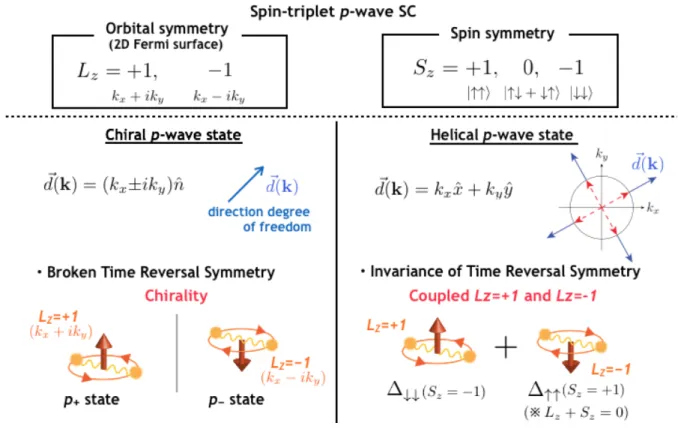
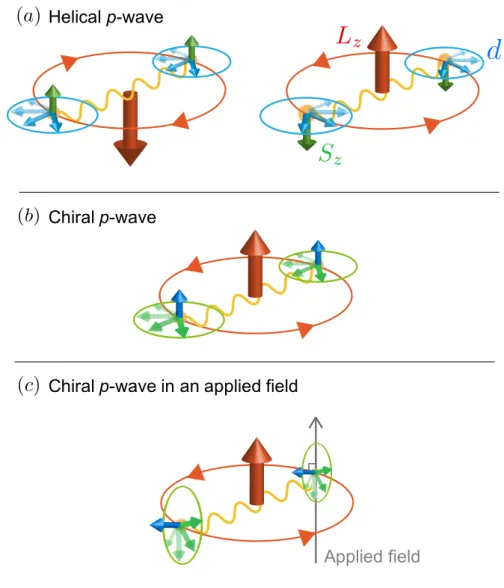
![Fig. 2.4 (Left figure) The Fermi surface of Sr 2 RuO 4 . Calculation is performed by the code WIEN2K [45] and using the structural data from Ref](https://thumb-ap.123doks.com/thumbv2/123deta/5842011.1038475/13.892.143.750.114.422/left-figure-fermi-surface-calculation-performed-wien-structural.webp)
